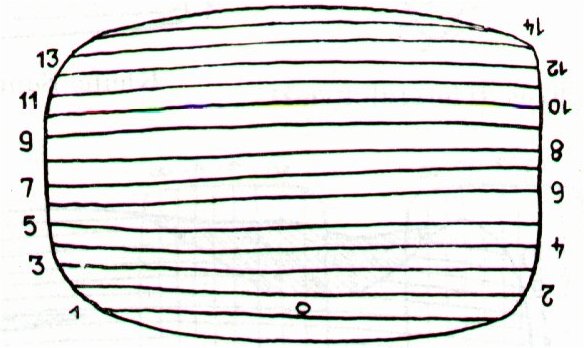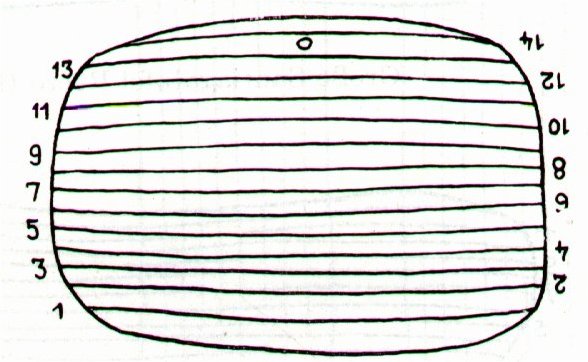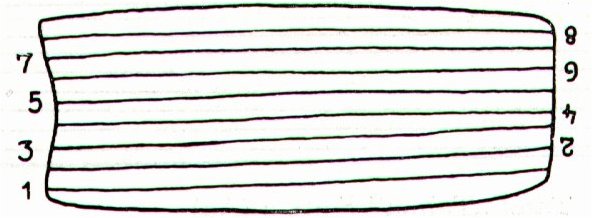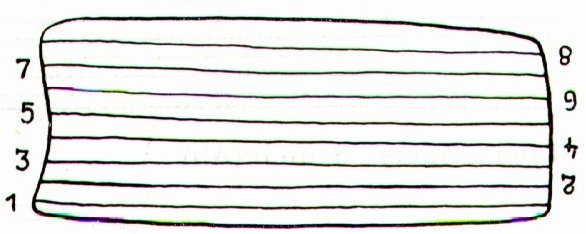Once again. The C tablet is softly rounded and somewhat like the Full Moon face, whereas the G tablet has a more rectangular outline. Form and content should be in harmony and therefore the C text could well have been intended for such nakshatra readings which would turn the northern star positions around to suit the seasons on Easter Island.
There is a pair of 'nuts'
at the beginning of line Ca4, first a dark one and then a light
one:
 |
 |
 |
|
Ca4-1 (77) |
Ca4-2 |
Ca4-3 |
|
kua tupu te rakau |
kua tupu - te
kihikihi |
te hau tea |
|
NODUS I (260.0),
π Herculis (260.7), Ras Algethi (260.8) |
Sarin (261.0), ο Ophiuchi (261.4)
Alrisha |
ξ
Ophiuchi (262.2), θ Ophiuchi, ν Serpentis, ζ, ι
Apodis (262.4), ι Arae (262.8), ρ Herculis
(262.9) |
|
December 6 (340) |
7
(*261 = 9 * 29) |
8 |
|
μ
AURIGAE,
μ
LEPORIS
(77.6) |
ĸ Leporis (78.0),
RIGEL (78.1),
Flaming Star (78.2),
CAPELLA
(78.4), ο Columbae, τ Orionis (78.8)
Thuban
|
λ
AURIGAE
(79.0),
λ
LEPORIS
(79.6), ρ Aurigae (79.7)
Arcturus
|
|
June
6 (157 = 314 / 2) |
7 |
8 |
Metoro suggested
'ashes' (kihikihi) for the glyph corresponding to
the position of
Rigel and Capella.
| Kihi
Kihikihi, lichen;
also: grey, greenish grey, ashen.
Vanaga.
Kihikihi, lichen T, stone T.
Churchill.
The Hawaiian day was divided in three
general parts, like that of the early
Greeks and Latins, - morning, noon, and
afternoon - Kakahi-aka, breaking
the shadows, scil. of night;
Awakea, for Ao-akea, the
plain full day; and Auina-la, the
decline of the day.
The lapse of the night, however, was
noted by five stations, if I may say so,
and four intervals of time, viz.: (1.)
Kihi, at 6 P.M., or about sunset;
(2.) Pili, between sunset and
midnight; (3) Kau, indicating
midnight; (4.) Pilipuka, between
midnight and surise, or about 3 A.M.;
(5.) Kihipuka, corresponding to
sunrise, or about 6 A.M. ... (Fornander)
|
I guess this old head of
light (fire) was said to come alive again at dawn,
incorporated in the new
generation of growth just as his preceding old dark twin head
had done.

Rigel and Capella were very bright stars in contrast to
the preceding μ (watery) stars:
When Metoro said
kua tupu te rakau for the time prior to Rigel and
Capella it could have referred to a dark night sky with
the stars still visible, before they would fade away because the Sun
was rising. The growth in
Ca4-1 was then not a real growth down on earth but something
similar, a presentiment of the growth in Ca4-2 representing
what
would happen down on earth when the Sun really returned.
The Tree (rakau)
should be searched for in the night sky and not down on
earth, that is my conclusion. And the Sirius pillar (Te
Pou) would be at the Full Moon in December 30 (364)
when the Sun stood tall in high summer, as possibly was
illustrated in Ca4-21:
 |
 |
 |
 |
 |
|
Ca4-21 |
Ca4-22 |
Ca4-23 |
Ca4-24 (100) |
Ca4-25 |
| ihe pepe rere |
ka rere ki tona nohoga |
te moko |
manu rere |
tupu te rakau |
|
ν Pavonis (280.4), κ Cor. Austr. (280.9) |
Abhijit-22 |
no star listed (282) |
ζ Pavonis (283.4), λ Cor. Austr. (283.6),
Double Double
(283.7), ζ Lyrae (283.8) |
South Dipper-8 |
|
θ Cor.
Austr. (281.0), VEGA (281.8) |
Φ SAGITTARII (284.0), μ Cor. Austr. (284.6), η
Cor. Austr., θ Pavonis (284.8) |
|
December 26 (360) |
27 |
28 |
29 |
30 (364) |
| ν Gemini, β Monocerotis (97.0) |
no star listed (98) |
ν Puppis (99.2), ψ3 Aurigae
(99.4), ψ2 Aurigae (99.5)
Gemma
|
ψ4 Aurigae (100.5), Mebsuta
(100.7) |
SIRIUS (101.2), ψ5 Aurigae
(101.4), ν Gemini (101.6), ψ6 Aurigae (101.7) |
|
June 26 (177) |
27 |
28 |
29 |
30 (181) |
|
Pepe
1. A sketch. 2. Bench, chair,
couch, seat, sofa, saddle; here pepe,
mau pepe, to saddle; noho pepe,
a tabouret. Pepepepe, bedstead. 3.
Pau.: butterfly. Ta.: pepe, id. Mq.:
pepe, id. Sa.: pepe, id. Ma.:
pepe, a moth; pepererau, fin,
Mgv.: pererau, wing. Ta.: pereraru,
id. Ma.: parirau, id. Churchill.
Sa.: pepe, a
butterfly, a moth, to flutter about.
Nukuoro, Fu., Niuē,
Uvea, Fotuna, Nuguria, Ta., Mq.:
pepe, a
butterfly. Ma.: pepe,
a grup, a moth; pepepepe,
a butterfly; pepeatua,
a species of butterfly. To.: bebe,
a butterfly. Vi.: mbèbè,
a butterfly. Rotumā: pep,
id. Churchill 2.
Mq.: Pepepepe, low,
flat. Ha.: pepepe, id. Churchill. |

...
According to the 'Butterflies' chapter in Kwaidan:
Stories and Studies of Strange Things, by Lafcadio
Hearn, a butterfly is seen as the personification of a
person's soul; whether they be living, dying, or already
dead ... The Ancient Greek word for 'butterfly' is
ψύχη
(psychē), which primarily means 'soul', 'mind'
...
... The
Taoist philosopher
Zhuangzi
once had a dream of being a butterfly flying without
care about humanity, however when he woke up and
realized it was just a dream, he thought to himself 'Was
I before a man who dreamt about being a butterfly, or am
I now a butterfly who dreams about being a man?' In some
old cultures, butterflies also symbolize rebirth into a
new life after being inside a cocoon for a period of
time ...
 |
199 |
 |
|
Ga1-16 |
Ca4-21 |
|
160 |
360 |
But the Tree was
hardly covering only a single day:
... the oak
had made trouble right from the start. When (in the
second rune of the Kalevala) Sämpsä Pellervoinen
had sowed trees, it was the oak alone that would not
grow until four or five lovely maidens from the water,
and a hero from the ocean, had cleared the ground with
fire and planted an acorn in the ashes; and once it had
started, the growth of the tree could not be stopped:
And
the summit rose to heaven // And its leaves in air
expanded, // In their course the clouds it hindered, //
And the driving clouds impeded, // And it hid the
shining sunlight, // And the gleaming of the moonlight
...
From December 6 (340) up to and including
December 30 (364) there were 25
days and 2 more rakau glyphs, although Metoro
preferred another expression for the first of them:
 |
 |
 |
 |
|
Ca4-13 |
Ca4-14 |
Ca4-15 |
Ca4-16 (92) |
|
kua tuu tona mea |
te henua |
te hau tea |
mauga hua - te henua |
|
ζ Serpentis (272.4), τ Ophiuchi (272.9) |
Winnowing Basket-7 |
Zhōngshān (274.0), π Pavonis (274.6) |
ι Pavonis (275.1),
Polis
(275.9)
Menkar
|
|
18h (273.4) |
|
NASH
(273.7), θ Arae (273.8) |
|
December 18 |
19 |
20 |
SOLSTICE
(355) |
|
η Leporis
(89.0),
PRAJA-PĀTI, MENKALINAN, MAHASHIM, γ COLUMBAE
(89.3), η
Columbae (89.7) |
μ Orionis
(90.3), χ² Orionis (90.5) |
6h (91.3) |
ξ Orionis
(92.5) |
|
ν Orionis
(91.4), θ Columbae (91.5), π Columbae (91.6) |
|
June 18 |
19 |
20 |
SOLSTICE (172) |
 |
 |
 |
 |
|
Ca4-17 |
Ca4-18 (94) |
Ca4-19 |
Ca4-20 |
|
te hau tea |
tupu
te rakau - te henua |
te hau tea |
tupu te rakau |
|
η Sagittarii
(276.9) |
Purva Ashadha-20 |
Kaus Borealis (279.3) |
|
KAUS
MEDIUS,
κ Lyrae (277.5), Tung Hae (277.7) |
φ Oct. (278.1),
KAUS AUSTRALIS
(278.3), ξ Pavonis (278.4), Al Athfar
(278.6) |
|
December 22 |
23 |
24 |
25 (359) |
|
Al Han'ah-4 /
Maru-sha-pu-u-mash-mashu-7 |
Furud (94.9) |
Well-22 /
Arkū-sha-pu-u-mash-mashu-8 |
no star
listed (96) |
|
TEJAT PRIOR
(93.4), γ
Monocerotis (93.5), κ Aurigae (93.6), κ
Columbae (93.8) |
δ Columbae
(95.2),
TEJAT POSTERIOR,
Mirzam (95.4),
CANOPUS
(95.6), ε Monocerotis (95.7), ψ1 Aurigae
(95.9) |
|
June 22 |
23 (St John's Eve) |
24 (St John's Day) |
25 (176) |
In rongorongo times there was an Oak Tree
stretching high in
the northern midsummer while its roots were far down at the southern
midwinter, and there were 3 stars in
Auriga and 1 in Columba marking where these
solstices began:

|













